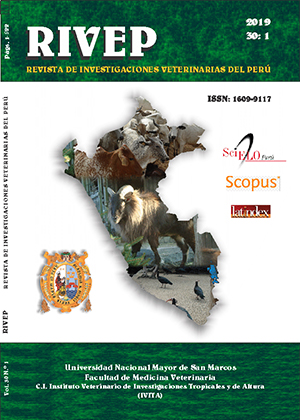Pathogenicity of a Yersinia ruckeri strain from an outbreak of yersiniosis in rainbow trout (Oncorhynchus mykiss) from Huaraz, Peru
DOI:
https://doi.org/10.15381/rivep.v30i1.15695Keywords:
Yersinia ruckeri; rainbow trout; pathogenicity; redmouth diseaseAbstract
The objectives of this study were to determine the pathogenicity of a strain of Yersinia ruckeri, from an outbreak of yersiniosis in Huaraz and to characterize histopathological lesions in various organs of rainbow trout fingerlings (Oncorhynchus mykiss). One hundred fingerlings with an average weight of 7.25 g were used, divided into 5 groups of 20 individuals (four experimental and one control), kept in 30 L ponds. Experimental groups were inoculated via i.m. with 0.1 ml of the bacterial strain in concentrations of 1x104/ml (G1), 4x104/ml (G2), 1x108/ml (G3) and 4x108/ml (G4), and the control group with PBS. Clinical signs, external and internal lesions, morbidity and mortality were recorded for 12 days post-inoculation. Samples of liver, intestine, spleen, kidney, muscle and gills were collected for histopathological analysis. All fish inoculated with Y. ruckeri showed signs and lesions compatible with yersiniosis. Most of individuals had inappetence and melanosis, as well as splenomegaly, mucous content in the intestine and intestinal congestion. Mortalities were 65 and 60% for G1 and G2, respectively and 100% for G3 and G4. Fat degeneration was found in liver, necrosis in intestine and muscle, presence of melanomacrophages and congestion in spleen and kidney, hyperplasia and fusion of lamellae in gills. Results indicate that Y. ruckeri strain from Huaraz is highly pathogenic.
Downloads
Downloads
Published
Issue
Section
License
Copyright (c) 2019 Mario Vargas L., Fernando Mesías V., Alexander Cueva Q., Alberto Manchego S., Nieves Sandoval C.

This work is licensed under a Creative Commons Attribution-NonCommercial-ShareAlike 4.0 International License.
AUTHORS RETAIN THEIR RIGHTS:
a. Authors retain their trade mark rights and patent, and also on any process or procedure described in the article.
b. Authors retain their right to share, copy, distribute, perform and publicly communicate their article (eg, to place their article in an institutional repository or publish it in a book), with an acknowledgment of its initial publication in the Revista de Investigaciones Veterinarias del Perú (RIVEP).
c. Authors retain theirs right to make a subsequent publication of their work, to use the article or any part thereof (eg a compilation of his papers, lecture notes, thesis, or a book), always indicating the source of publication (the originator of the work, journal, volume, number and date).










